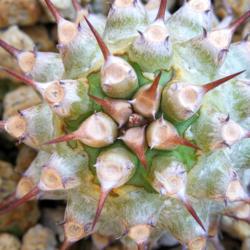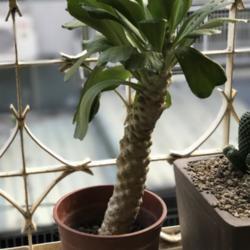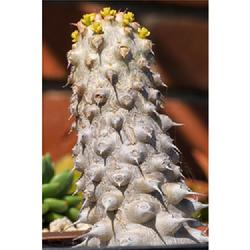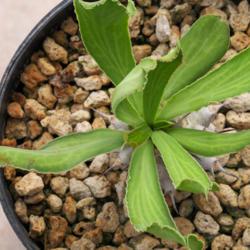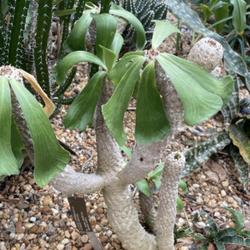General Plant Information (Edit)
| Plant Habit: |
Cactus/Succulent
|
| Life cycle: |
Perennial
|
| Sun Requirements: |
Full Sun
|
| Plant Height: |
10-20 feet |
| Leaves: |
Deciduous
|
| Fruit: |
Pops open explosively when ripe
|
| Flowers: |
Other: In the genus Euphorbia, the flowers are reduced in size and aggregated into a cluster of flowers called a cyathium (plural cyathia). This feature is present in every species of the genus Euphorbia but nowhere else in the plant kingdom.
|
| Bloom Size: |
Under 1"
|
| Suitable Locations: |
Xeriscapic
|
| Dynamic Accumulator: |
B (Boron)
|
| Resistances: |
Deer Resistant
Rabbit Resistant
Squirrels
|
| Toxicity: |
Other: All members of the genus Euphorbia produce a milky sap called latex that is toxic and can range from a mild irritant to very poisonous.
|
| Containers: |
Needs excellent drainage in pots
|
| Miscellaneous: |
With thorns/spines/prickles/teeth
Dioecious
|
Posted by
Baja_Costero (Baja California - Zone 11b) on Apr 7, 2024 9:31 PM concerning plant:
One of a handful of deciduous spiny stem succulents from West Africa that become large, chunky-stemmed, multi-branched shrubs after many years. The species name is misleading (there may be one main stipular spine, but usually also two more smaller ones).
Very seasonal (summer-fall) growth pattern. The leafy phase is associated with stem extension, while the leafless phase is typically when flowers (tiny yellowish cyathia) appear. Water more frequently from late spring through fall, especially when the plant is in leaf. In our mild winter rainfall climate, these plants enjoy regular winter water (in moderation) and mostly tolerate the rain (given good drainage).
This species (like its toxic West African relatives) is tropical in origin and seems to be marginal where heat is lacking. Here where high temperatures are in the upper 60s and 70s for most of the summer, these plants rarely have much foliage and tend to grow very slowly.
« Add a new plant to the database
» Search the Euphorbias Database: by characteristics or by cultivar name
« See the general plant entry for Euphorbias (Euphorbia)
« The Euphorbias Database Front Page
« The Plants Database Front Page
